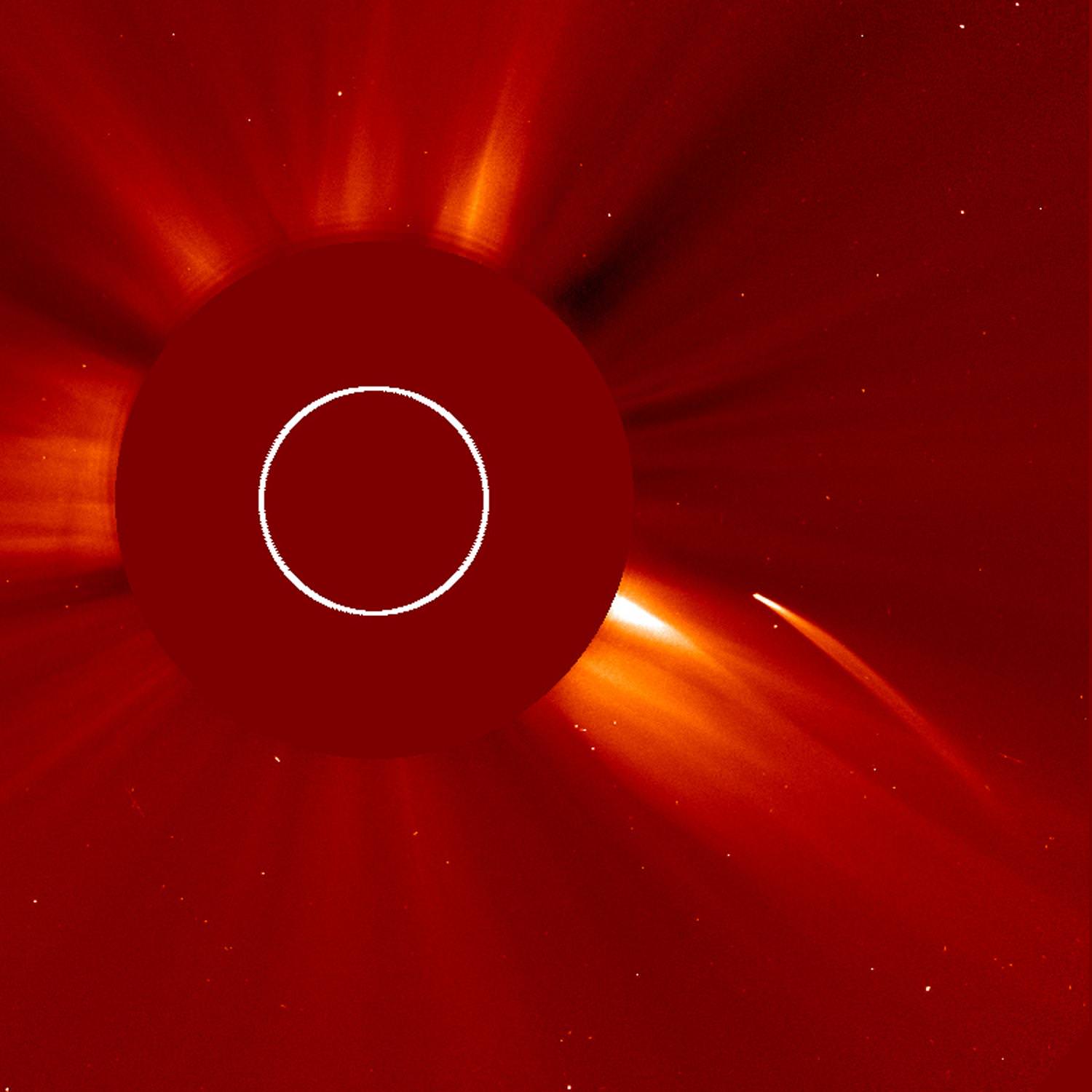Using ground-based and space-based observations, a team of researchers has been monitoring a difficult-to-see comet carefully. It’s called Comet 323P/SOHO, and it was discovered over 20 years ago in 1999. But it’s difficult to observe due to its proximity to the Sun.
They’ve found that the Sun is slowly tearing the comet to pieces.
Comets with the SOHO designation were discovered with the SOHO spacecraft. The Solar and Heliospheric Observatory (SOHO) is a joint ESA/NASA mission launched in 1995. Its mission is to study the Sun, and though the mission was scheduled to last two years, it’s been operating for over 26 years.
As a by-product of its solar observations, the spacecraft has discovered 4,000 comets. Most of these comets are Sungrazers, a class of comets very close to the Sun. Astronomers think most Sungrazers are chunks of a much larger comet that broke apart. 323P isn’t a Sungrazer; it’s a near-Sun comet. Small comets can completely evaporate in one close approach to the Sun, while larger ones can survive many. For most of them, their small perihelions spell their eventual doom.
Comet 323P/SOHO’s perihelion is only 0.04 astronomical units. Its orbital period is just over four years. In 2020, observations with the Subaru telescope showed that the comet had no cometary features as it approached perihelion. But that changed.
“However, in our post-perihelion observations, it developed a long, narrow tail mimicking a disintegrating cometary debris cloud,” the authors write in their paper.
The paper is titled “The Lingering Death of Periodic Near-Sun Comet 323P/SOHO.” The first author is Man-To Hui from the State Key Laboratory of Lunar and Planetary Science, Macau University of Science and Technology. The others are from institutions in the USA, Germany, Canada, and Taiwan.
Sungrazers have perihelions smaller than Mercury’s. Astronomers think they’re main-belt asteroids or short-period comets that were drawn closer to the Sun via the gravitational influence of giant planets or as a consequence of ancient impacts. Sungrazers usually don’t last very long. Their lifetimes seldom surpass 10 million years, according to astronomers, due to their orbit in the inner Solar System. Not only do they have to contend with the Sun’s gravitational power, they frequently cross the paths of the terrestrial planets.
According to the new paper, 323P/SOHO is flirting with destruction. The researchers identified two 20 meter diameter fragments coming from the comet shortly in March 2021. They also found that the comet lost between 0.1-10% of the mass of its nucleus. It looks like its end is near.

The comet’s nucleus is only about 172 meters (560 ft) in diameter. It rotates quickly, at 0.522 hr., the most rapid rotation of every known comet in the Solar System. According to the authors of this paper, that means that the nucleus has high cohesive strength. That strength might help it survive more gravitational encounters with the Sun.
If it seems strange that the researchers only observed the comet’s debris tail after it left perihelion, that’s because of how difficult near-Sun comets are to watch. At perihelion, the Sun’s brightness renders the comets nearly unobservable. They’re observable in any detail outside of perihelion.
There are far fewer observed near-Sun objects than models show there should be. Part of the reason for that is the difficulty in observing them in the Sun’s glare. But the other reason is that astronomers expect them to disintegrate into millimetre-sized particles due to thermal destruction. Even so, observing them being turned to dust is difficult. There’s not much good-quality observational evidence of them breaking apart.
This study is among the first instances of comets like these being observed with ground-based observatories.

The team concluded that the comet may have been an ordinary Jupiter-family comet as little as 1,000 years ago. But Jupiter-family comets themselves originated as Kuiper-Belt objects and contain many frozen volatiles. They should form a noticeable tail when heated by the Sun. But that’s not the nature of 323P’s debris tail. “Rather, it is most likely triggered by the rotational instability, plus the enormous thermal stress induced by the huge temperature gradient within its nucleus around perihelion,” the authors conclude.
323P may continue to survive its close encounters with the Sun, partly because of its high cohesive strength. But it won’t last much longer, partly because of its rotational instability and partly because it has a strong orbital resonance with Saturn. That resonance will decrease its perihelion and increase its orbital eccentricity. For those reasons, Comet 323P/SOHO is doomed.
According to the paper, “… 323P has a likelihood of 99.7% to collide with the Sun in the next two millennia.”
More:
- Research: The Lingering Death of Periodic Near-Sun Comet 323P/SOHO
- Heavens Above: Comet 323P SOHO
- Universe Today: Did a Comet Wipe out the Dinosaurs?

